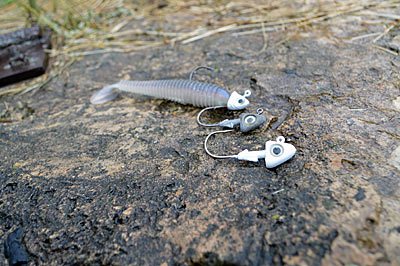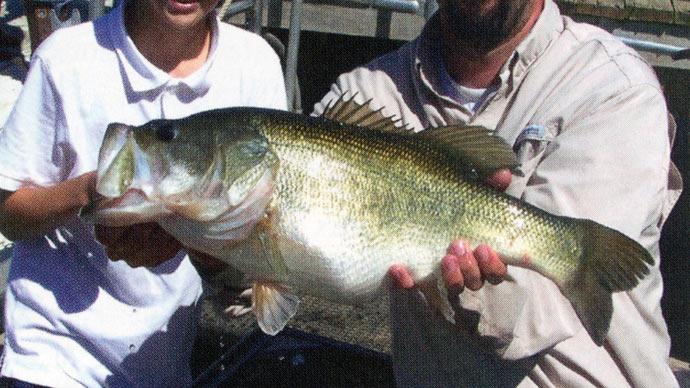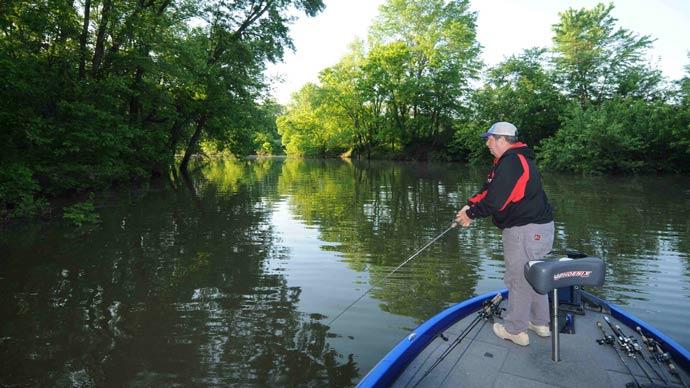
Davy Hite wrote an extensive B.A.S.S. tournament resume before retiring from competition in 2016. He won the 1999 Bassmaster Classic, bookending that triumph with Angler of the Year titles in 1997 and 2002. He amassed eight B.A.S.S. wins, including his last in 2011. It was on Pickwick Lake, a Tennessee River impoundment that spreads across Mississippi, Tennessee, and Alabama.
In that tournament, Hite ran upstream to the tailwaters of Wilson Dam, where he used a swimbait to catch 20 bass that weighed 84 pounds and 9 ounces, distancing second place by 8 pounds. The commitment wasn’t without some rough seas, as spats of falling water levels and reduced current throughout the four-day tournament forced the South Carolina angler to adjust continuously. But even with that volatility, he knew the potential for a positive outcome was strong.
Tailwater bass are predictable in terms of their location and how they feed. That made them a good option for Hite on Pickwick and for you wherever you can find them. But like all bass, they aren’t without their nuances. Understanding and applying the best approaches will catch you more of them. Here’s how to do that.
Tailwaters defined
Bass are mobile creatures. They swim anywhere their fins take them: deep water, shallow water, small creeks, or across expansive natural lakes. And in rivers and the upper end of reservoirs, a population always swims in the tailwaters.

Tailwaters are the stretch of river or reservoir impacted by water released from a dam immediately upstream. On rivers like the Mississippi, dams, and locks are built to control flooding and permit commercial navigation. Spaced apart and built large enough, reservoirs can form between the dams. A well-known example of the latter is the Tennessee River reservoirs, which include Guntersville, Kentucky, Wilson, and Pickwick.
Tailwaters are riverine, even in reservoirs. They offer shallow and deep water and a mix of hard structure and cover rock, ledges, and stumps. Aquatic vegetation and shoreline cover, such as laydowns or docks, often lack because the current can run strong.
The amount of current in a tailwater can change hourly, daily, or even weekly. Locks, for example, create pulses of current as vessels are lowered. If the dam is used to generate electricity, you can expect more current below on hot, humid summer days when everyone is running their air conditioner full blast. And significant rainfall upstream can force operators to open the dam’s gates, moving more water downstream to stop flooding.
The attraction
Regardless of its strength, the current is what makes tailwaters bass producers. Smallmouth spotted, and largemouth bass is all found in tailwaters but not in the same spots. Like elsewhere in a reservoir or river, each gravitates to the spots where they feel most comfortable. Smallmouth, for example, are at home in small eddies surrounded by the fastest current. Spotted bass will use current nearly as fast, and you’ll find both, along with largemouth, in the slowest current.
Current keeps bass in a tailwater for one big reason: food. It’s washed to them, making feeding efficient. There’s no need to chase roaming schools of baitfish like their neighbors down the lake.
Tailwater bass also enjoy the water that’s more oxygenated during the hot summer months, thanks to the turbulence. While that may not attract bass, it makes the ones that live there more active in various depths.
Go with the flow
The current dictates the lives of tailwater bass. Bass seek shelter behind rocks, ledges, and other obstacles. These patches of slack water — eddies — form in any amount of current. Concentrate your casts at these spots and the seams that lead downstream from them.
Fish the ones that match your target bass species. Suppose you are after smallmouth, target eddies surrounded by the fastest water. But if it’s largemouth that you’re after, look for eddies in slower water, which is usually found farther downstream and sometimes along the bank closer to the dam.
While some current is needed to form eddies, more aren’t formed as current increases. That only makes fishing more difficult. Bass are pinned into the most sheltered spots, and if you find them, boat positioning becomes too difficult to present a lure to them successfully. In those cases, you’re better off fishing elsewhere.
You can judge the amount of current before arriving at the tailwater. Take note of floating objects as you make your way up the reservoir or river from the ramp. If all the moored boats, for example, are pointing upstream and the shoal and channel makers are leaning downstream or have water boiling around them, the dam is moving lots of water.
Tackle considerations

Hite’s Pickwick plan centered around targeting bass waiting in the eddies below Wilson Dam for shad to be washed by. He targeted these spots with swimbaits, which changed as the flow increased and decreased. And while the soft-plastic body remained the same, he constantly searched for the correct size jig head.
From reel to the lure, all your gear must match the current amount. It will never go completely slack, even during a drought. But as it slows, it’s easier for bass to move around more. And that means you’ll have more ways to catch them.
Tailwater bass focus on baitfish, so choose lures that mimic them. When current is slow, try topwaters, such as poppers and walking lures, spinnerbaits, and crankbaits. Easily upset by faster current, these lures can quickly cover a lot of water, precisely what you need to accomplish as bass spread out under these conditions.
Lure options diminish as current increases. With bass gathering in eddies, anglers need lures that can be cast accurately and slip easily through the fast-moving water. Jigs and soft-plastic lures are good choices. But a better option is to follow Hite’s lead and fish swimbaits. They are available in various sizes and colors, making it easy to match the local forage. And they can be rigged several ways, including Texas-style, or impaled on a jig head’s single upturned hook. They cast like a dream and fish at any depth or speed.
Jigs, soft plastics, and swimbaits share one more beneficial characteristic for fishing in changing currents: It’s easy to adjust their weight. By carrying a selection of weights — in the case of swimbaits, different size jig heads — you can match your offering to the current. If it’s ripping, add more weight to keep your swimbait where you want it.
The current affects other parts of your setup. Large diameter lines create more drag than smaller ones. So, use braided line instead of spooling your reel with monofilament or fluorocarbon. Most offer more strength with less diameter. And if you’re worried about more visible braid spooking clear water bass, tie in a short — 18 to 24 inches is plenty — leader of less visible fluorocarbon or monofilament.
Besides being more accurate casters, baitcasting reels manage the line better. Current grabs excess line, creating a bow that deadens sensitivity, making it difficult to detect strikes. Stopping the spool with your thumb as soon as the lure lands minimizes excess line.
Play it safe
Even the slowest current can create a dangerous situation if you fall from your boat, including being swept away or under an obstruction. That danger increases exponentially as the current runs faster, and even the best swimmers struggle. While those have bleak outlooks, there are ways to protect yourself.
First and foremost, wear your personal floatation device. PFDs come in various styles, with most bass anglers choosing a foam-filled or inflatable model. There are advantages and disadvantages to both.
Foam-filled PFDs float as soon as the wearer enters the water. But their bulk can make them uncomfortable, especially on hot summer days. That means anglers are more likely to shed one while fishing, which won’t help unless worn.
Inflatable PFDs feel less restrictive. Many bass anglers wear them the entire time they’re on the water. That’s important in some states, where they must be worn to be a legally required PFD. They require regular maintenance, ensuring the carbon-dioxide cylinder is charged and swapping out the inflation activation tab.
Be careful if you anchor. Water can be released quickly. It can pull your boat under if you don’t have time to free your anchor. Increased current can wash free logs and debris, which could ram your boat, possibly knocking an occupant overboard.
Prepare for more current by calling the dam operator or checking its website for upcoming release times. That way, you can plan your trips around the strongest flows, when fishing is at its lowest and danger at its highest. Some dams also have audible signals, such as a horn, activated prior to release. Always keep an ear trained for one when you’re on the water.




